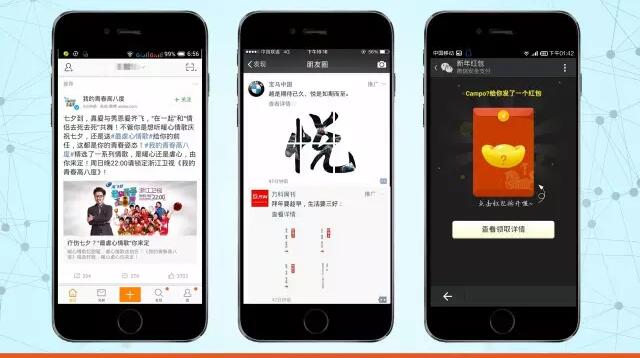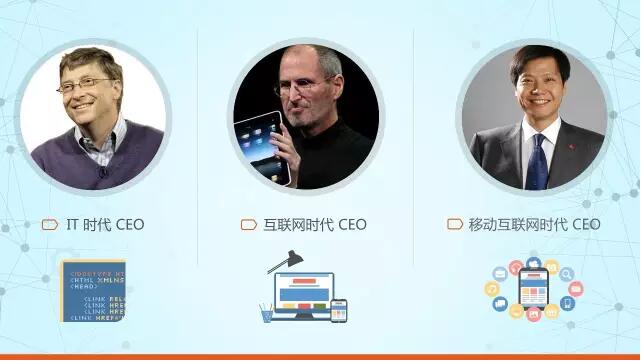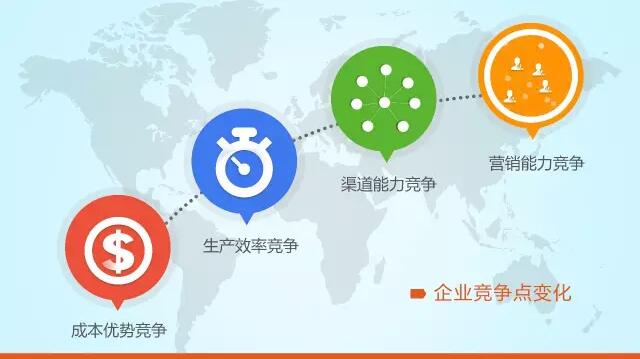Digital marketing is an ever-evolving business filled with numerous ideas, concepts and trends. The history of internet, to some point, is a history of evolving digital marketing models.

Digital marketing channels in China are mostly controlled by BAT, their affiliates and associated allies. They fight fiercely for advertisers, but also have distinctive core clientele.
Portals are the main digital marketing channel in the early days, and information display was the common marketing technique. Their clients are mainly brands. The core logic of this marketing practice is same with TV or other traditional media advertising, which is to make the advertisement memorable by repetitive playing or displaying. The disadvantage with this technique is limited capacity. When advertisements reach a certain amount, banners will fill the screen, hurting advertising effect.
Search ads are smarter. This tactic allows marketers to publish targeted ads in front of a defined audience who has intention to buy particular products. The benefit is higher efficiency, but disadvantage is not all purchases and commodities can be promoted this way. It’s more rewarding to place ads when consumers do not have clear intentions to buy. It’s actually too late when consumers start searching for certain products.
The advent of e-commerce (including online transactions of physical goods, as well as online booking but offline services or transactions) enables producers to both display their products and complete a transaction via digital channels. Digital marketing can improve conversion efficiency (marketing converted to actual sales increase).
But on an online shopping website which allows cost transparency and price comparisons, sellers can only display information about their products instead of selling their products at a price premium consumers are usually willing to pay to a well-known or acknowledged brand. What’s more, there are too much information and false comments on the web, and too many fake commodities on the shelves. It’s extremely hard to build a brand on such a platform.
The new generation of social media like Weibo and WeChat has provided marketers and consumers a more compound digital environment and a more inclusive digital marketing arena than what old search engines, portals and e-commerce platforms offered. Information display, word-of-mouth broadcasting, brand communication, after-sales services, loyalty program, targeted marketing, and even payment can all be realized on one platform, which also fits and integrates the mobile networks accessed by consumers.
More importantly, sellers can establish a long-term relationship with buyers, which makes new deals possible in the future. If sellers can successfully get consumers who once bought their products recommend them to others on the social media, this might bring explosive traffic with very low cost, which is also the beauty of e-commerce on social media.
The value of social media will be ultimately manifested by bringing endless orders to sellers via mobile internet. Low-cost traffic which drives these orders will make brands with such connective capacities more competitive in terms of reducing marketing cost, like what Xiaomi has over its rivals.
But not many companies have obtained this “connectivity value” for two main reasons: a) most companies’ knowledge of social media marketing stops at broadcasting by content or punchlines, which is basic PR or content marketing. b) Most companies do not have the infrastructure of connectivity management, which are technologies or software that syndicate content, battles, customer service, CRM, mobile e-commerce and advertising, also analyze data and update work modes. Without the infrastructure, it’s like just curing the head when one has a headache. Only partial and simple marketing innovation is realized, which can hardly improve ROI on the whole.

Before WeChat’s big improvement, Brands found themselves in a predicament trying to carry out social media marketing similar to that on Weixin.
But WeChat has the best team who has strategic vision and learns fast. It systematically learned native advertising from Facebook, and mimicked Weibo’s lessons learned about user experience from starting with SMEs instead of big brands. WeChat’s own marketing system starts to take shape after it has tried and tested “Red Package” product with strong Chinese characteristics.
It’s nothing new to businesses to use incentives to motivate consumers to try out products/services and recommend them to people they know, which then lead to purchase actions. It’s also very common to provide bigger discounts or privileges to critical channels or certain VIP users.
A combination of the afore-mentioned promotional tool, social networking on WeChat, “red package” and e-payment mounts to a very practical yet innovative idea to WeChat’s counterparts in the world, which is stimulating consumers to share some information as marketers want among their networking circles by providing spendable digital currency incentives. That’s why Didi Dache managed viral transmission of its red packages, which themselves have become a digital marketing channel that multiple brands compete to work with.
WeChat promised to gradually open its red envelope platform to all authenticated companies. In the future, distributing red envelopes and coupons to spur word-of-mouth marketing and to increase purchases will prove to be a more effective and controllable way of marketing than relying on ideas and jokes.
To take one step further, it will become a more and more critical issue for brands to contemplate how much they should spend on advertising and how much they should directly give to the first layer of consumers (namely fans and members) to incentivize them to bring explosive amount of traffic. It will be a very hard decision to make if companies don’t have the support of Social Touch’s software, data and experiences.
During the most recent Spring Festival Gala, WeChat has distributed all the budget form marketers to consumers in the form of red envelopes without charging an intermediary fee. This might be the beginning of a new history, indicating that the commercial chain of advertisers--media buying-media-audience might crash. On the old ash will rise a new marketing value chain “advertisers—giveaways calculating and distributing—we-media—other audience motivated by we-media. This change of model means an enterprise advertising market worth RMB 500bilion a year.
Early 2015, WeChat launched native advertising inside Moments, and set the pricing very high from the start through its successful strategy of aiming at well-established clients. WeChat attracts lots of users to interact and comment on the ads thanks to its strategy of semi-inviting commercial partners and its pragmatic attitude of relentlessly testing advertising effect and users’ reaction. However, this also once again attest to the unique and core value of native advertising, which is that right ads are not an harassment, but in nature a value-added service for users.
Targeted and native advertising in Moments, together with effective red-envelope incentives to motivate reached users, have basically formed the embryonic form of WeChat’s marketing form, which will eventually eclipsed other digital marketing channels in terms of efficiency and effectiveness.
Although powerful, WeChat’s marketing mechanism faces two potential risks and uncertainties in the future. One is the Open ID design embedded in Official Account function, which is the most strict protection mechanism of users’ ID information among all social networks in the world. However, this mechanism severely prevents companies from recognizing consumers’ digital identities and in turn restricts the possibilities of cooperation among companies to cross-sell products to consumers.
Given this, it’s another uncertainty with Chinese digital marketing whether WeChat will adopt a more open and flexible strategy of targeted native advertising release that is based on customer profiles to support companies.
On the front of social media data accessibility and value exploring, Sina Weibo as the second largest social media platform has many impressive achievements in 2014. First of all, Weibo realized 200% growth in sales with its data-digging-based effect marketing, despite the fact its marketers are the most demanding SMEs. This is not only a demonstration of Weibo’s capacity growth in advertising selling, but more importantly a reflection of the value of its native advertising.
Secondly, Weibo has opened up its capacity of targeted ads release based on UID, phone numbers, and email addresses to the extent of Facebook’s practices. We have tried part of this capacity with Sina and also realized unbelievable conversion effect. In addition, Weibo started to commercialize its ads release strategies, which means it can sell successful data package to similar clients. This innovation will further fuel the growth of data-driven marketing strategies and products.
This can draw up the conclusion that genuinely effective marketing has to couple with data collection, statistics, calculating and re-use regardless of the platform (be it WeChat or Weibo). In addition, the whole process has to be supported by specially designed software; otherwise there won’t be scientific marketing and effectiveness improvement.

In the history of modern enterprises’ evolution, the heroic images of CEOs usually correlate with the business competition theme of their time. At the inchoate stage of IT industry, there were a group of technicians/scientists/professionals-turned-to CEOs and managers, such as Andy Grove, CEO of Intel and Bill Gates of Software. At the era of internet and digits when most innovation is found in products and application, product-manager style CEOs such as Steve Jobs or Pony Ma become exemplary.
At current time of mobile internet, the focus of competition among companies has shifted onto fighting for better relationship with customers. In industries where competition is extraordinarily fierce, CEOs have acted. Lei Jun, CEO of Xiaomi, wants to be “friends” with fans loving Xiaomi mobile handsets. Luo Yonghao, CEO of Smartisan Technology, tries to build a bigger fan base for its products by face-to-face sharing of anecdotes about his startup businesses and video broadcasting. In food, restaurants, consumer electronics, and other industries, a large number of CEOs who are articulate dreamers and advent believers in close communication and cooperation between internal departments and consumers have emerged. I believe this type of CEOs will become the face of next-generation management, whom I call “Connective CEO”.
In addition to the shifting focus of CEOs, the marketing management organization is also undergoing various and rapid changes. In the cover story of Harvard Business Review, 7th issue of 2014, it proposed that a modern marketing organization is in desperate need of a new type of experts, which it names “Chief Marketing Technologist”. Only with CMTs’ help could companies use latest digital marketing technologies more effectively, craft and execute strategies most conducive to corporate development including application of big data technologies and capacities.
Now all companies need to pore over their organization to identify who is responsible for the process and results of marketing technologies and data software in their internal and external service functions. If this person is missing for long, corporate marketing will not be able to catch up with the trend in the changing future.
As the focus of digital marketing is shifting from media buying to customer-oriented communication management, marketing departments whose traditional role is to manage media buying are now realizing consumer services and communication on social media has become increasingly important so that they have to manage to improve consumer experiences. In addition, the importance of content marketing has led more companies to think about the possibilities of building content-producing capacities of their own.
As new digital marketing channels grow, departments of content producing, ads release, e-commerce operation, consumer loyalty management, word-of-mouth monitoring and maintenance, and even traditional PR management that used to run solo under the bigger division of marketing now clearly need to operate under a unified framework. Cooperation is needed, and real-life inter-departmental walls need to be torn down. More importantly, the strategies, execution and data management of these departments, as well as goals, performance evaluation, continuous monitoring and interpretation of process data and KPI, need to be further synchronized and consolidated.
All of this has led to a rising phenomenon that marketing departments are abandoning its slim organization, putting more staff under CMO. If we call departments inside an organization that have direct contact with consumers “the front desk”, they are expanding in scale too. We can put things in light by imagining the large number of channel-building and retail-selling staff needed for traditional companies of national layout. It is natural that no small number of staff is needed for a business with similar scale who decides to go digital marketing.

We are entering an age of connectivity, which is ubiquitous between products and information, people and people, products and products, with the list going on. At such a time, connectivity management has never been as important as now, playing such a decisive role in the life or death of a company. There are profound social, economic and technical reasons behind this.
The society has developed so much that consumers are presented with superabundant resources and surrounded by immense amount of information. Except quite a few innovation-defining companies, most ones’ products can be replaced and accessed easily by consumers. Given this, the part in business management where consumers are acquired, namely marketing, has become more important and heavily burdened.
From the perspective of economic development trend, most companies’ competiveness evolve from cost advantage, productivity advantage, channel capacity advantage, and then gradually to marketing edge. Especially with growing labor cost, there is limited room to improve production and management efficiency in lots of industries with mature production line, many of who then realized that they could and have to optimize their channels and marketing. The core competitiveness of many new products or brands on social media is mostly about reducing their marketing cost with their knowledge and capabilities, then forming an advantage of higher cost efficiency, to rapidly grab market shares.
On technical level, emerging social media network and open platforms have created exponentially growing consumer data, which companies can access and reference to release their ads. Cookie-based programmatic buying is also being accepted by advertisers and the media.
However, the true game-changing data that will revolutionize the efficiency of digital marketing is those social media IDs of consumers that have interactions with sellers. With these data, companies can make and optimize their decisions regarding products innovation, customer service, advertising, SCDP (the same customer, different products) and value-added services. This will be the most obvious opportunity window for most companies to benefit from big data technology and application.
In our development course over the past three years, there is a growing and deepening understanding inside Social Touch that evolving and competitive multiple digital marketing channels means more customer relationship on the digital platform for companies to maintain at the same time. To maximize the marketing effect, companies need these digital channels to connect, link and consolidate. But these emerging internet platforms, which either have natural monopoly or have teamed up with each other aspiring to be the next big players, do not have intrinsic motives to meet this demand from companies.
Therefore, here comes Social Touch who wants to be strategic partners of companies and stands firmly on their sides, helping them build connection with consumers and manage the complex connection between different channels, big data and various applications more effectively.